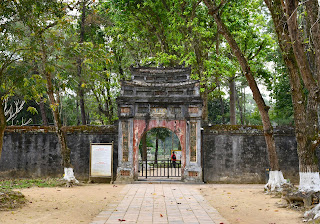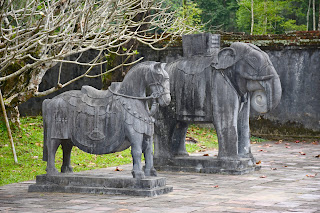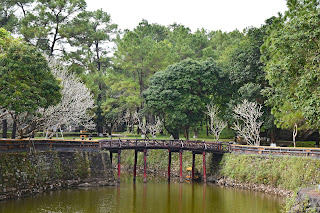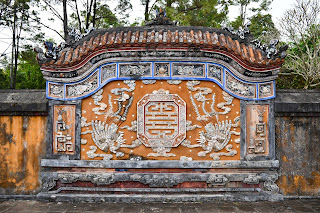Vietnam North to South – Day 7: Huế
In contrast to the hectic itinerary of yesterday, we spent the whole day today in one city. After eating a leisurely breakfast, we boarded a “dragon boat” on Perfume River and sailed for about forty minutes to the Thiên Mụ Temple, founded in 1601 by the Nguyens. Its most impressive sight is its seven-story pagoda, which directly overlooks the river and serves as an entry point to a much larger complex. Besides the usual temples, this complex also contains a functioning monastery and a few historical exhibits. Perhaps the most interesting artefact is the car driven to Saigon by the Monk Thích Quảng Đức, who immolated himself in protest against the anti-Buddhist persecutions of the staunchly Catholic president Ngô Đình Diệm.
We spent the rest of the day touring the tombs of the
Nguyen rulers Minh Mạng, Khải Định, and Tự Đức. The first was very symmetrical
yet expansive and by no means lacking in greenery. Minh Mạng had spent much of
his time in that area even before his death, choosing the location and having
it landscaped based on the principles of fengshui. Once we had walked through
the main courtyards and buildings, we continued to ramble about the park. My
dad and I sauntered along the lake, climbing the hillocks every now and then to
see the foundations of ruined buildings.
Khải Định’s tomb was the most impressive, built into
the hillside and richly decorated despite its black and white theme. Just like Minh
Mạng’s tomb, it featured a stone menagerie of horses, elephants, and
attendants, but this one was arrayed beneath two massive steles. Inside the
main building and under a lavish canopy sat a glistening statue of the ruler,
his photograph placed on top of an altar in the front room. One of the
buildings also featured a truly unique bas relief of bats, which seemed
strangely appropriate on the black stone. Some buildings also struck me as
somewhat more western than the rest, which I would attribute to French
influence.
The tomb of Tự Đức was the most deceptively expansive,
featuring a whole tomb complex dedicated to the emperor’s wife. The park also
had some quaint wooden bridges and little temples built for various deities.
Once we had left the burial site, we also made a stop by a store on a road full
of incense stores. We were shown how incense stick are traditionally made, and
also got a short demonstration on the manufacture of Vietnamese conical hats.
In the evening, my dad dragged me out to visit a
supermarket in search of durians and chicken salt, an item that had entranced
him on our boat ride through Ha Long Bay. We found neither, but we were able to
at least replenish our stock of sunflower seeds and buy some nuts.




































































Comments
Post a Comment